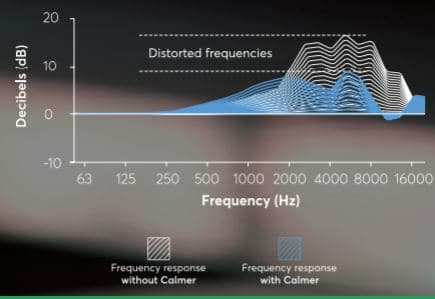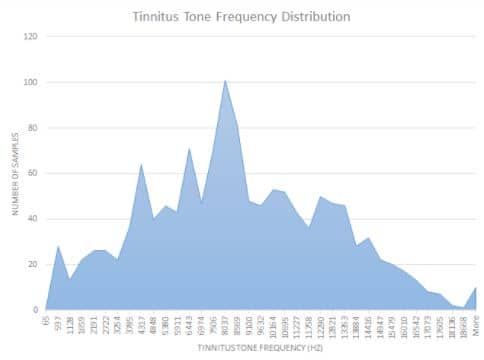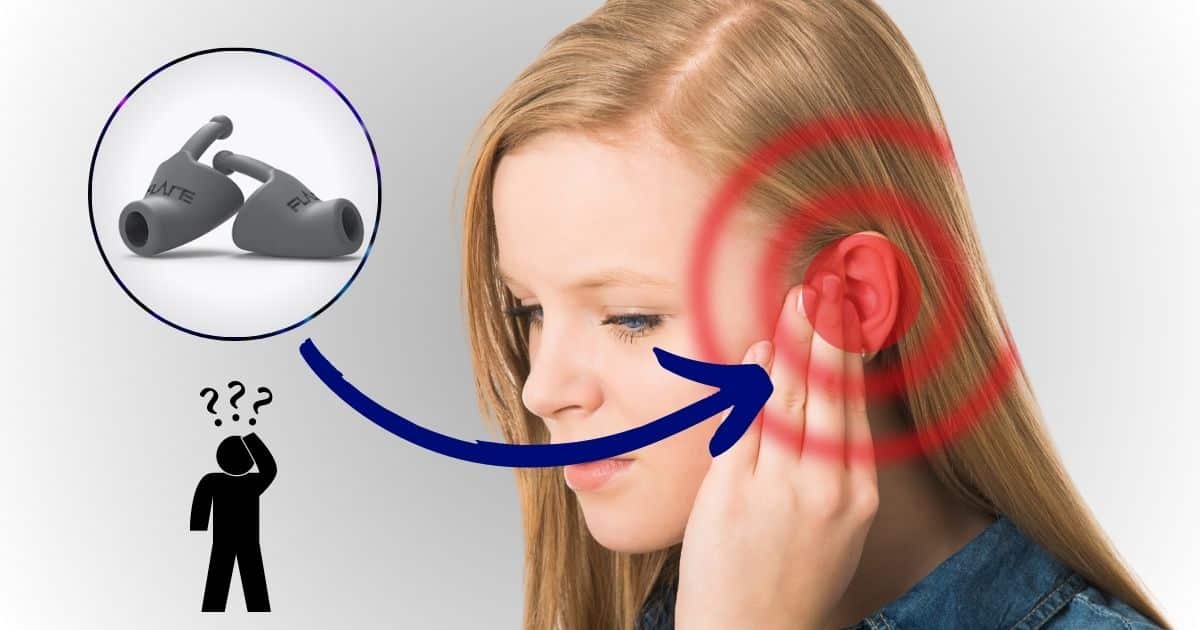by Ben Thompson, AuD
Today we’re here to talk about Flare Audio’s new device called Calmer. It’s a small rubber device that goes in your ear, and there have been reviews and claims that this could help tinnitus. Today, as an audiologist, I’m going to help answer the question: does Flare Audio’s Calmer help tinnitus?
Does Calmer Help With Tinnitus?
First, let’s get into the science. What really is this device? On the surface, this is a small silicone piece with a hollow center which fits directly into the ear. In a sponsored Facebook ad from Flare Audio, the company that makes this product, they say that Calmer is an “in-ear tech device to help some people reduce tinnitus and sound sensitivities.” They describe Calmer as a “soft silicone in-ear waveguide that removes resonance from inside of our ears.”
This company makes a lot of audio products. Most of them will not be controversial, but now they have this product which is claiming to help some people’s tinnitus. That can be controversial because people think, is this a snake oil product? There’s no known medical cure for tinnitus. So why are they even advertising something like that?
I was looking through the Flare Calmer reviews myself, a lot of people are saying Calmer is absolutely no help to tinnitus. Pulling up an image from Flare Audio’s Calmer internal research, they found that with this device in the ear canal, it reduces the high frequency input or high pitch sound coming into your hearing system by about 10 decibels.

Image credit: flareaudio.com
Using Calmer may be harmful for your tinnitus. The reason most people have tinnitus is because there is some slight hearing damage in the inner ear, in the cochlea. In our ears we have the ear canal, up to the eardrum, and past the eardrum is the hearing organ, the cochlea.
Most people who have hearing loss also have damage in the cochlea. Most people who have tinnitus have some slight damage or slight deficit of hearing, and that’s usually in the cochlea as well. So if I increase your hearing loss in the cochlea, then your auditory brain, which is the source of the tinnitus, would create more tinnitus. More hearing loss, more tinnitus. The less sound you can hear through your ear, the stronger and louder the replacement or phantom sound becomes in the auditory brain.
The Calmer is a small rubber tip in the ear. Acoustically, it reduces sound similar to a big piece of earwax. Wearing these little pieces in your ear creates a mild high-pitch hearing loss, which creates more tinnitus. From a scientific perspective, these devices do not make any sense to help with standard tinnitus. In fact, there is a possibility that with Flare Calmer your tinnitus could actually worsen.
There have been claims online that by using Flare Calmer tinnitus symptoms can be improved. And there’s been some Flare Calmer reviews saying that it helps some people with their sound sensitivity or tinnitus.

Image credit: audionotch.com
In my scientific opinion, research refutes the idea that these devices will help most types of tinnitus. Most people have tinnitus centered around 8000 hertz: that’s the pitch or the sound quality of their tinnitus. So, putting something in your ear that would make your hearing around that frequency worse is a bad idea, and I don’t recommend it.
Flare Audio Review Tinnitus
I’ve personally worn this device for a few hours, and what it really does is change the hearing of the world around me. It makes it softer. That’s what these devices were designed to do. They weren’t designed for tinnitus at all.
So, did this little rubber tip in my ear actually help tinnitus? Well, I have mild tinnitus, and I put these devices in actually hoping that they would have some small electrical component to play soothing sounds, because sound therapy–having access to more sound, or a sound-rich environment–is the key to reshaping the neural networks in the auditory system and reducing the perception of tinnitus.
These devices are actually just a little less impactful than an earplug. They essentially are an ear plug with a hole in the center. It’s not blocking out all the sound around you, it’s just blocking out some of the high-pitch sound.
If you have standard tinnitus, I do not recommend trying the Calmer. If you have sound sensitivity, however, it might help–for example, if it’s really hard for you to be in a crowded place, because the crowd is noisy, and it bothers you, and that triggers your tinnitus.
The Calmer was found primarily to reduce the overall volume of the surrounding sounds, similar to an earplug with a hole in the center. While it was not designed specifically for tinnitus relief, individuals with sound sensitivity in noisy environments might find it helpful in managing their tinnitus triggers. However, for individuals with standard tinnitus, the device may not provide the desired relief or sound therapy component.
Does Calmer Help With Hyperacusis?
If your tinnitus is triggered by loud sounds and loud environments, then you probably have some form of sound sensitivity, which is also called hyperacusis.
For hyperacusis treatment and management, you may use earplugs to help slowly desensitize yourself to the sounds that trigger you. So for example, if you cannot go outside because the street noise is too loud, then the way to desensitize that is to use earplugs and slowly wean yourself off of them over time. Now, this little device can be used in that sense, because it has a hole in the middle of it, so it’s not as strong as a typical earplug.
But does that mean that it’s going to help your tinnitus? No.
Does it provide any soothing effect on your tinnitus? No.
Does it prevent the actual trigger of louder noises, and change how that could affect your tinnitus? Yes, that’s possible.
The reason that some people are giving Flare Calmer positive reviews for their tinnitus is most likely because they also have sound sensitivity. When they’re in a place that is noisy, like a party or out on a busy street, these devices make it a little softer. If you are triggered by loud noise, that would help you, but if you just have loud tinnitus, and you’re not really bothered by sounds other than your tinnitus inside of your head, then this doesn’t make any sense for you.
Using earplugs can be an approach to gradually desensitize oneself to triggering sounds for the management of hyperacusis. However, it’s important to note that while the Calmer device with a hole in the center can reduce the impact of louder noises, it does not provide direct soothing effects or treatment for tinnitus. Positive reviews of the device may be attributed to individuals who also experience sound sensitivity, finding the device helpful in softening environmental sounds. It is unlikely to be effective for most types of tinnitus that are not specifically related to sound sensitivity.
Unfortunately, Calmer will not help most kinds of tinnitus.
If Calmer doesn’t help my tinnitus, then what?
So if you tried this device, and it didn’t help your tinnitus, or you’re thinking about trying it and aren’t sure, what do you do? There is a 100-day guarantee for a return, but Flare Audio has pretty expensive shipping rates because they’re in Europe. So from the US, it would cost you a lot of money to ship this back to get the return.
Personally, I don’t recommend trying this device unless you have sound sensitivity.
Fortunately, other tinnitus treatments exist that are supported by medical research. These include cognitive behavioral therapy and tinnitus retraining therapy.
Wondering what to do if you have tinnitus? Read more in this helpful resource: 8 Things You Should do if You Have Tinnitus.
About the Author Dr. Ben Thompson is an audiologist and tinnitus expert. Dr. Thompson is the founder of PureTinnitus.com. He completed his residency at University of California at San Francisco (UCSF) and is a past board member of the California Academy of Audiology. Via telehealth, Dr. Thompson provides services to patients with hearing loss and tinnitus.
Dr. Ben Thompson is an audiologist and tinnitus expert. Dr. Thompson is the founder of PureTinnitus.com. He completed his residency at University of California at San Francisco (UCSF) and is a past board member of the California Academy of Audiology. Via telehealth, Dr. Thompson provides services to patients with hearing loss and tinnitus.







Thanks Ben, your honest analysis will save T sufferers money and frustrations, and possible relapses. Your work is appreciated as always!
You’re welcome, Neale!
I saw a thread about Calmer earplugs in one of my neurodiverse Facebook groups. The poster did emphasize they really weren’t effective for tinnitus, but I was intrigued by the other claims so I ordered a pair: I was hoping that they would ease the physical stress and headaches from the many Zoom and phone calls required for work.
For two days I thought “are these bulls***??” but then I realized that while the effect is subtle I feel more “protected” while wearing them, like the audio version of a weighted blanket. And they really help mitigate the distortion from bright perky call voices that make me miserable by the end of the day! There is also some lessening of the stress from next-door construction and other city noise. Finally, I do notice my tinnitus is more pronounced (only while wearing them, and even then not all the time), but I’m guessing this is because it’s not hindered by the extra noise within the included frequency range.
They sound so nice for someone with hearing sensitivity issues
Thanks for the review
This makes sense! I highly appreciate it, I am getting Calmer soon because I have sensory processing issues, and hearing is one of them. I had noticed in the reviews that most, if not all of the bad reviews were from people with tinnitus, but mostly good reviews from people with hearing sensitivity. I think Calmer should adjust their advertisement and stop portraying it as a treatment for tinnitus. I do think their ads targeting autistic people and those with sensitivities will reach a better audience that Calmer can actually help.
Great to see a scientific perspective.
It’s interesting to see that they have now removed any reference to tinnitus, so it looks like they have actually listened to the experts and focused on people this type of noise dampener can actually help like those who struggle with sound sensitivity!